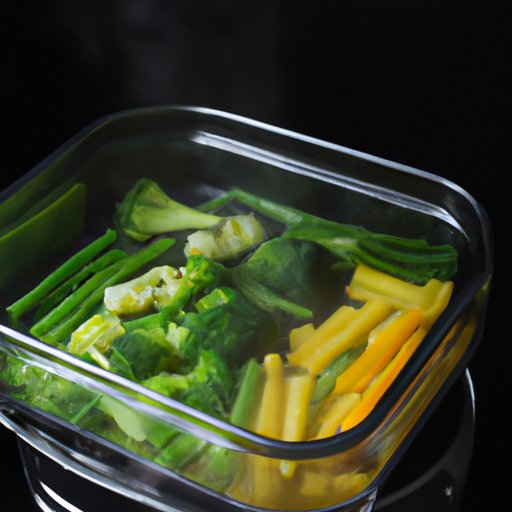Introduction
Steaming is one of the healthiest and easiest ways to cook vegetables. Not only does it help retain most of the nutrients and vitamins, but it also adds flavor without using any oil or fat. In this article, we will guide you through the process of steaming vegetables, give you some recipe ideas, and share some tips for retaining the most nutrients in your veggies.
A Step-by-Step Guide
When steaming vegetables, it’s important to choose the right vegetables that will steam well. It’s generally recommended to use fresh vegetables that are not too ripe or mature to achieve the best results. Some examples of vegetables that are great for steaming include broccoli, cauliflower, carrots, green beans, and asparagus.
To steam vegetables, you’ll need the following equipment:
- A steaming basket or colander
- A pot with a lid
- Water
Here are the steps to follow:
- Fill your pot with about an inch of water and bring it to a boil over high heat.
- Place your steaming basket or colander over the pot, making sure it doesn’t touch the water.
- Arrange your vegetables in the basket or colander and cover the pot with its lid.
- Steam your vegetables according to their cooking time. For example, broccoli and cauliflower take about 5-7 minutes, carrots take 10-15 minutes, and green beans take 5-6 minutes.
- Once the vegetables are cooked, remove them from the pot and serve immediately.
Alternatives to Traditional Steaming Methods
While traditional steaming is the most commonly used method, there are alternative ways to steam vegetables, such as microwaving, sautéing, and roasting.
Microwaving is the quickest method, but it may not result in the same texture or flavor that traditional steaming provides. To steam vegetables in the microwave, simply place them in a microwave-safe dish with a small amount of water. Cover the dish with a lid or plastic wrap and microwave on high for about 5-7 minutes, stirring once or twice.
Sautéing is a great alternative for those who want to add some flavor to their veggies. To sauté vegetables, heat up some oil in a pan and add your vegetables. Cook over medium-high heat, stirring occasionally, until they are slightly crispy.
Roasting is another healthy option for cooking vegetables. Simply place your vegetables in a single layer on a baking sheet, drizzle with oil and seasonings, and roast in the oven for 20-30 minutes at 400°F.
Easy and Healthy Steaming Recipe Ideas
Steamed vegetables can be served as a side dish or as a main course. Here are some recipe ideas:
Steamed Broccoli with Garlic:
Cook broccoli in your steamer basket for 5-7 minutes. Mince some garlic and sauté in a pan with olive oil over medium-high heat for a minute. Toss the broccoli in the garlic oil and add a sprinkle of salt and pepper.
Steamed Asparagus Salad:
Cook asparagus in your steamer basket for 5-7 minutes. Mix together some olive oil, balsamic vinegar, Dijon mustard, salt, and pepper. Pour the dressing over the asparagus and top with shaved Parmesan cheese.
Steamed Carrots and Green Beans:
Cook carrots in your steamer basket for 10-15 minutes and green beans for 5-6 minutes. Toss with lemon juice, olive oil, and a sprinkle of salt and pepper.
These recipes are not only delicious, but they also provide a healthy dose of vitamins and minerals.
Tips for Retaining the Most Nutrients
The longer vegetables are cooked, the more nutrients they lose. To retain as many nutrients as possible, it’s best to cook vegetables for the least amount of time possible. You can speed up the steaming process by cutting your veggies into smaller pieces or by blanching them before steaming.
Other factors that can help retain nutrients include using a steamer basket instead of boiling vegetables, using as little water as possible, and cooking vegetables with their skins on.
Steaming for Beginners
If you’re new to steaming vegetables, don’t worry. It’s a simple process that requires minimal equipment. All you need is a pot with a lid and a steamer basket or colander. You can steam almost any type of vegetable, from broccoli to zucchini.
Some recipe ideas for beginners include steamed sweet potatoes, steamed green beans, and steamed carrots. You can also experiment with different seasonings, such as lemon juice, garlic, and herbs.
Conclusion
Steaming vegetables is one of the healthiest ways to cook them, and it’s also one of the easiest. We hope this guide has been helpful in teaching you how to steam vegetables, providing you with some recipe ideas, and sharing tips on how to retain the most nutrients. We encourage you to try steaming vegetables at home and experiment with different veggies and seasonings.
